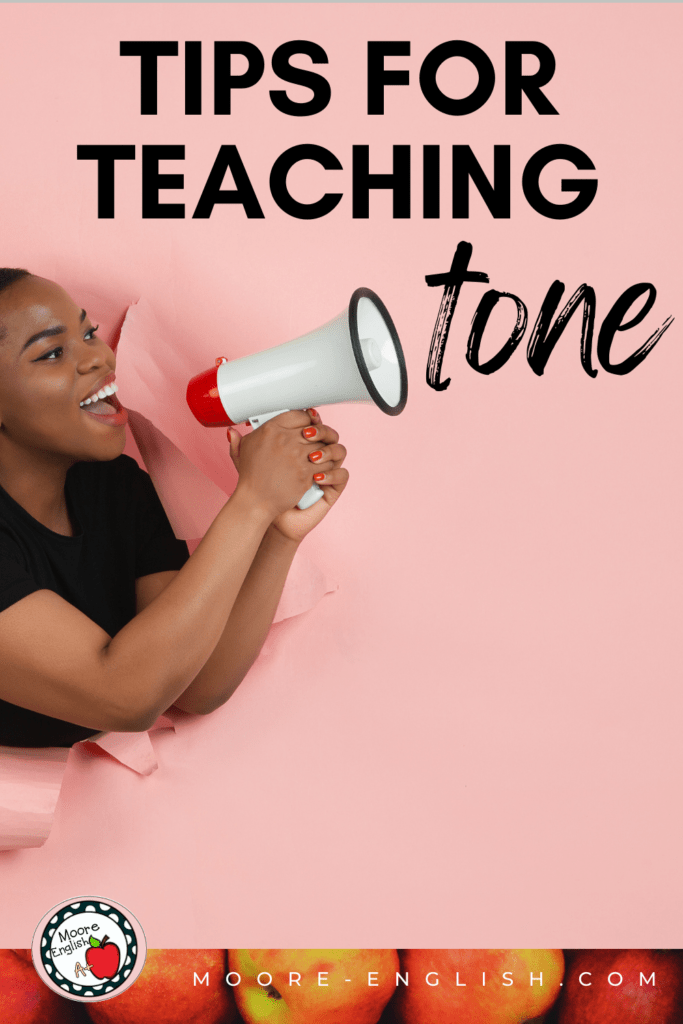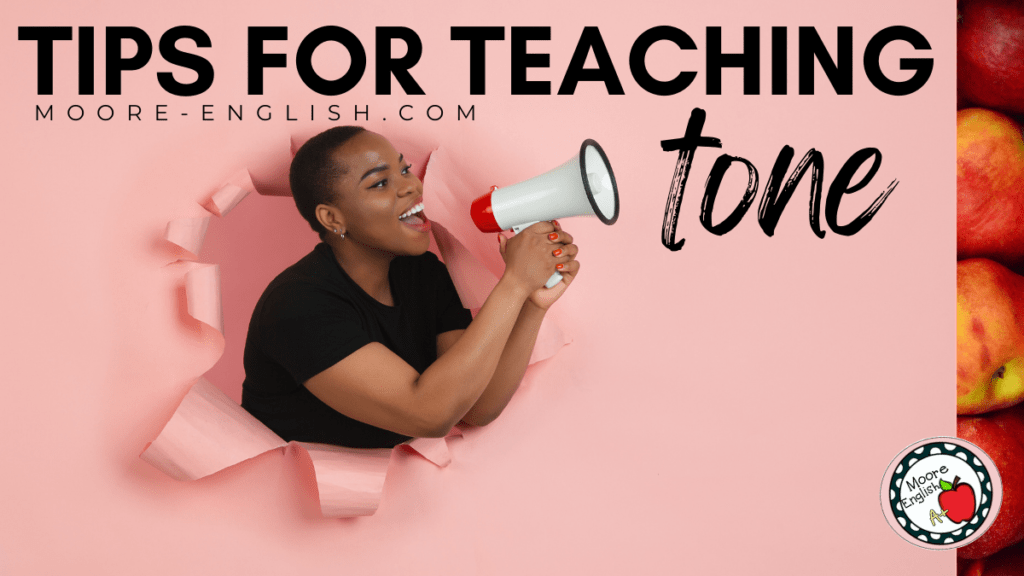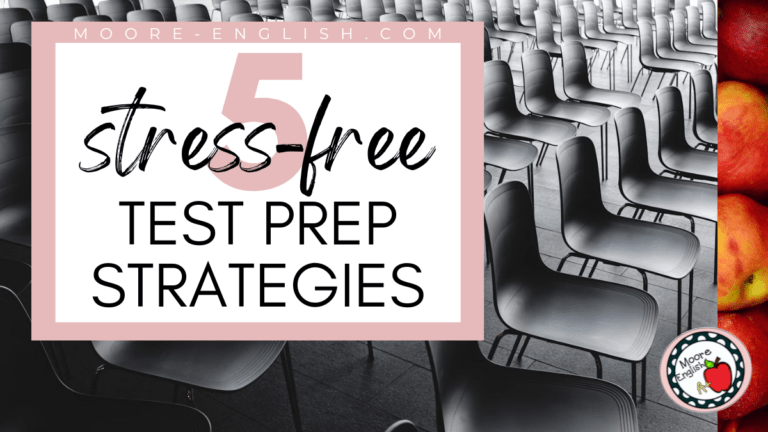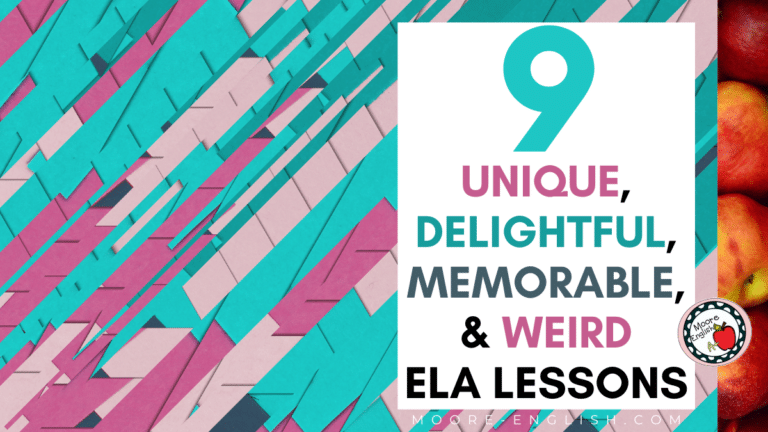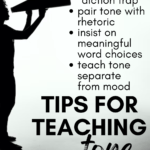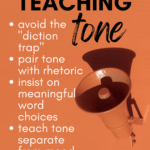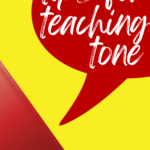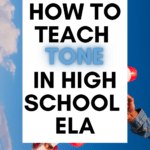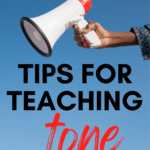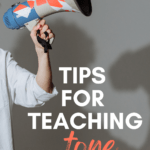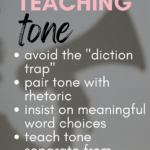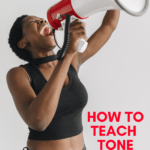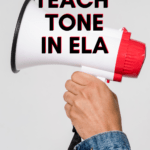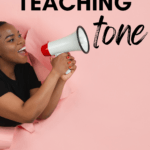Tone is one of the most challenging topics for students. What’s more, tone is oftentimes a tough topic for teachers to tackle. Over the years, I’ve made all the mistakes when it comes to teaching tone. For these reasons, I want to share the lessons I’ve learned about what it takes to make the most of teaching tone.
Teaching Tips
- First, don’t teach mood and tone together. I don’t know how or why these terms are linked in our ELA subconscious, but this is the #1 struggle for students. So avoid this hurdle just by decoupling these terms.
- Second, insist that students make better word choices when describing tone. “Serious” and “formal” are lame tone words. Just don’t let students stop generating terms until they choose more meaningful descriptions of the tone.
- Next, avoid the “diction trap.” Something happens when students learn the term “diction,” and they immediately want to start saying “well, the author uses diction.” Um…no. Do the same thing with tone. An author doesn’t use tone. An author creates tone to signal a purpose. That small change is the difference between nuanced analysis and blather.
- Finally, pair tone with rhetoric. So often the most powerful examples of tone are in persuasive and argumentative texts, advertisements, or commercials. This SOAPSTone graphic organizer is an ideal way to help students connect author’s purpose to tone.
How to Gamify Tone
Gamification is such a fun way to engage students in content. Adding a little competition and movement are a perfect way to spice up almost any lesson. Here are some of my favorite gamification strategies:
- First, the tone game is an absolute favorite. Students play in groups of 3-4. Each group receives a set of scenario and vocabulary cards. The vocabulary cards are dealt out to all the players. The dealer then reads the first scenario, and the remaining players choose from their vocabulary words which tone they best think describes the scenario. The dealer chooses the winner, who keeps the card, and the deal passes to the right. The winner is the player with the most vocabulary cards at the game. This is kind of like Apples to Apples for ELA!
- Second, if you’re pairing tone with rhetoric, task cards are a great tool for practicing new terms. One of my favorite features of task cards is that it’s easy for teachers to “stack the deck” and differentiate the tasks for each student. Grab my rhetoric task cards today!
- Similarly, if your students are less familiar with rhetoric, a card sort is a perfect strategy. Using card sorts is high engagement but also meaningful learning. I love a good card sort as bell work!
- Additionally, my students love BINGO. Even my seniors enjoy the familiar pace of BINGO. To play with a whole group, try Literary Devices BINGO. If you want to focus students down a little bit more, they can also try single-player BINGO. Both of these options also work well for days when the technology fails or you need to leave emergency sub plans!
- All together, teachers can mix and match different games and activities. Classroom stations are a good way to give students the chance to play multiple games or complete several activities. Plus, stations promote classroom collaboration and provide students with plenty of meaningful movement. Grab my favorite literary analysis stations!
Poems for Teaching Tone
Poems are one of my favorite ways to help students practice analyzing tone. Since poems are often nice and short, they can help teachers and students focus in on one or two skills. Similarly, poems can also be a good tool for intervention when a student or small group of students continues to struggle. Here are some poems that lend themselves to teaching tone:
- First, “To the Virgins to Make Much of Time” by Robert Herrick and “To Lucasta, Going to the Wars” by Richard Lovelace are a great poetry pairing. Both of these poems are straightforward in their tones, which are earnest if a little agonized. These poems do not pull punches so they are a great place to begin.
- Similarly, if you’re looking for more British literature, “If–” by Rudyard Kipling and “The Charge of the Light Brigade” Alfred, Lord Tennyson are excellent options. They are both longer but straightforward, so you can raise the rigor a step at a time.
- To continually scaffold upward, I like to show students how authors use punctuation and structure to intensify tone. Some poems to help students study this relationship include “The Summer Day” by Mary Oliver, “Deer Dance Exhibition” by Ofelia Zepeda, and anything by Emily Dickinson.
- Finally, nuance in tone is a struggle for students. As texts become more layered, students often struggle to see how tone evolves or to see shades of meaning. “When I Was One-and-Twenty” by A. E. Housman”, “One Art” by Elizabeth Bishop, and “For the young who want to” by Marge Piercy are all good options for achieving this goal.
If you’re also looking for poems to use for intervention or reteaching, these are some great poems that keep it simple but still have clear and moving tones:
- “Invictus” by William Ernest Henley
- “Ode to Teachers” by Pat Mora
- “Blueprints?” by Sara Holbrook
Short Works for Teaching Tone
As students become more adept at analyzing tone, it’s time to scaffold upward to longer texts where students can see how literary devices overlap and interact to create a unified perspective. These longer (but still short) texts are good options for leveling upward.
First, “Girl” by Jamaica Kincaid is one of the first short stories I think of when it comes to analyzing tone. This is also a good text for analyzing how structure affects an author’s purpose. Read it here.
Similarly, “The Yellow Wall-paper” by Charlotte Perkins Gilman is an ideal text for moving upward in terms of text length but also provides students with a chance to analyze tone. Plus, the speaker’s tone evolves throughout the text, so students can practice connecting tone and characterization. Read it here.
Finally, argumentative texts are a perfect window for connecting rhetoric and tone. These are some of my favorite nonfiction texts to use in the classroom:
- “Sinners in the Hands of an Angry God” by Jonathan Edwards
- “Nature” and “Self-Reliance” by Ralph Waldo Emerson
- “Civil Disobedience” by Henry David Thoreau
- FDR’s Four Freedoms Speech
- JFK’s Inaugural Address
A Complete Text Collection
If you are like me, sometimes the best units share a cohesive theme or common thread. As I was putting together this blog post, I wanted to also give you a themed option for teaching tone (because that’s what I want). For this reason, I put together this collection of texts that draw on mythology. My students love mythology, so that is always a great way to get them engaged.
- First, “Siren Song” by Margaret Atwood draws on the Siren scene in The Odyssey. The speaker has such a sassy yet apathetic tone that this is a perfect text. Read it here.
- Similarly, “Penelope” by Dorothy Parker provides a different perspective on the Penelope scenes from The Odyssey. This is another fun option, and it’s short enough to be a one-day lesson. Read it here.
- “Poor Icarus” by Florence Earle Coates also gives an alternative perspective on a familiar piece of mythology. Using a text like this is the perfect way to use an allusion to teach synthesis-level thinking. Read it here.
- Finally, “Ithaka” by C.P. Cavafy is a longer poem with a clear tone. This is a good way to add a little rigor while still keeping students focused on tone. Read it here.

